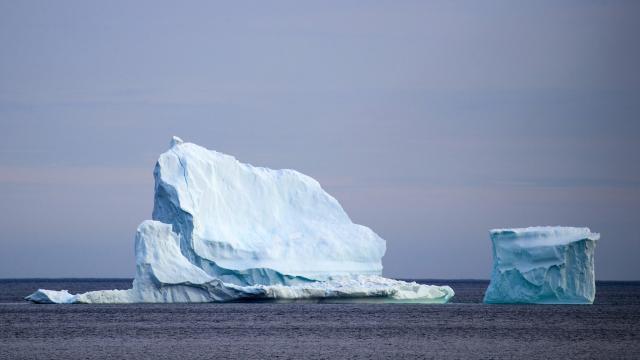Canada’s Arctic has been getting slammed by the climate crisis. The region hasn’t been this hot in at least 115,000 years, and its ice is suffering. But it had one intact ice sheet that was hanging on for dear life. Until now.
Canada’s last fully intact ice shelf has collapsed, the Canadian Ice Service reported this week. The shelf lost more than 40 per cent of its area in just two days at the end of July, the agency said. May it rest in peace.
The late Milne Ice Shelf was in northern Canadian territory of Nunavut, on the border of Ellesmere Island. The floating slab of ice it shed into the Arctic Ocean measured about 78 kilometres, which is larger than the entire island of Manhattan. Researchers knew the Milne Ice Shelf and the ice caps were goners long before they dropped off, but it’s still a shock to see it happen.
The Arctic has been heating up more than twice as fast as the rest of the world, but this year has been particularly hot. Heat waves have rippled across the region. Though Siberia has been the bullseye and seen widespread fires, Canada has gotten in on the action, too. Reuters reported that this summer in the Canadian Arctic has been 5 degrees Celsius above the 30-year average. On July 25, temperatures reached 21.9 degrees Celsius on the research base of Eureka on Ellesmere Island, which they believe may be the highest temperature on record so far north in history.
It’s not just the Milne Ice Shelf feeling the burn. Earlier this summer, Ellesmere’s two St. Patrick ice caps completely melted. The Arctic-wide warmth has also caused sea ice to hit its lowest July level in 40 years of record keeping.
A huge section of the Milne #IceShelf has collapsed into the #Arctic Ocean producing a ~79 km2 ice island. Above normal air temperatures, offshore winds and open water in front of the ice shelf are all part of the recipe for ice shelf break up. #MilneIceIsland #Nunavut #seaice pic.twitter.com/fGfj8Me9tA
— ECCC Canadian Ice Service (@ECCC_CIS) August 2, 2020
The collapse of the Milne Ice Shelf mirrors what’s been happening on the other side of the Earth in Antarctica, where a handful of high profile ice shelves have collapsed since the 1990s and glaciers are thinning at an alarming rate. So yeah, ice everywhere is having a rough go of it on our rapidly overheating planet.
This is bad news for us all. While ice shelves are floating, they often hold back land ice. Without shelves to act as doorstops, more land ice can spill into the sea and push up sea levels, which can overwhelm coastal communities. The Milne Ice Shelf holds back a comparatively small amount of glacial ice, but the Antarctic is a different story. New research published just last week shows sea level rise could cause $US14.2 ($20) trillion in infrastructure damage this century if we don’t curb carbon emissions. This is all just more reason that we need to get it together to curb carbon emissions, to slow global warming. We need to save the ice ” and ourselves.
